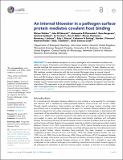An internal thioester in a pathogen surface protein mediates covalent host binding
View/
Date
02/06/2015Author
Grant ID
MR/K001485/1
094476/Z/10/Z
Keywords
Metadata
Show full item recordAbstract
To cause disease and persist in a host, pathogenic and commensal microbes must adhere to tissues. Colonization and infection depend on specific molecular interactions at the host-microbe interface that involve microbial surface proteins, or adhesins. To date, adhesins are only known to bind to host receptors non-covalently. Here we show that the streptococcal surface protein SfbI mediates covalent interaction with the host protein fibrinogen using an unusual internal thioester bond as a ‘chemical harpoon’. This cross-linking reaction allows bacterial attachment to fibrin and SfbI binding to human cells in a model of inflammation. Thioester-containing domains are unexpectedly prevalent in Gram-positive bacteria, including many clinically relevant pathogens. Our findings support bacterial-encoded covalent binding as a new molecular principle in host-microbe interactions. This represents an as yet unexploited target to treat bacterial infection and may also offer novel opportunities for engineering beneficial interactions.
Citation
Walden , M , Edwards , J M , Dziewulska , A M , Bergmann , R , Saalbach , G , Kan , S-Y , Miller , O K , Weckener , M , Jackson , R J , Shirran , S L , Botting , C H , Florence , G J , Rohde , M , Banfield , M J & Schwarz-Linek , U 2015 , ' An internal thioester in a pathogen surface protein mediates covalent host binding ' , eLife , vol. 4 , e06638 . https://doi.org/10.7554/eLife.06638
Publication
eLife
Status
Peer reviewed
ISSN
2050-084XType
Journal article
Description
This work was supported by the MRC, UK grant MR/K001485 for MW, JME, MR, MJB, USL; the BBSRC, UK grant BB/J00453 and the John Innes Foundation for MJB; the Wellcome Trust Institutional Strategic Support Fund 097831/Z/11/B for AMD; Wellcome Trust/JIF award 063597 and Wellcome Trust grants WT079272AIA and 094476/Z/10/Z to CHB for the BSRC Mass Spectrometry and Proteomics Facility; University of St Andrews and School of Biology for SYK; The Carnegie Trust for OKM.Collections
Items in the St Andrews Research Repository are protected by copyright, with all rights reserved, unless otherwise indicated.

